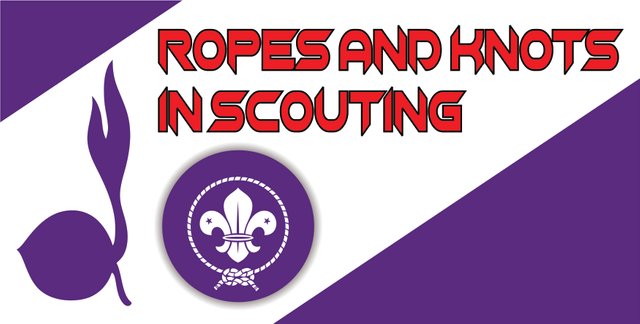Knowledge of Ropes and Knots in Scouting and Their Uses

In Scouting there are various kinds of knots according to their shape and function. This type of knot is useful for tying objects, connecting poles, or helping to lift weights. In Scouting, various knots include tools that help us survive or make it easier for various purposes that require ropes.

The knot is where the rope meets the rope. It is the formation of one or two strands of rope which later becomes another shape. In scouts, we recognize various types of knots, such as live knots, dead knots, base knots, anchor knots and others. I will share several types of knots and their uses.
1. Basic Knot (Overhead)
This knot is the basis for making other knots and this knot is widely used as a locking knot for other knots.

2. Dead Knot (Reef)
The function of this knot is to connect two ropes of the same size and not slippery. In this knot, the more you pull, the stronger the bond, but if you want to untie it, it's not difficult

3. Clove Hitch Knot
Clove Hitch is a knot that is widely used, this knot is usually used to start or end rigging activities, such as when tied to a tree, stick body, or other object with the intention that the knitting rope does not come off.

4. Anchor Knot
The shape of the anchor knot is almost like a Clove Hitch knot, but different, if the base knot is to start and end, the anchor knot is not, because if one end of the rope is pulled, the anchor knot can be released. Usually during activities, the anchor knot is used to tie all hollow objects such as anchors, rings, sticks for stretchers or tents.

5. Bowline Knot
Bowline knot / goat knot is usually used on climbers (worn on harness rope / body rope) but it should be underlined that if for a beginner it is not recommended to use this knot because this knot must be really careful in its conclusion, and if you are not careful then this knot will be easily detached so that something very fatal will happen. This knot is also used to tie something with a non-binding knot (e.g. goat's neck tie, tie to a pole). This knot will result in a loop of rope that can be increased or decreased again.

6. Double figure of eights
This variation of the eight knot is often called the bunny ear knot because of its adorable shape. In rock climbing, this knot is usually used to make anchors. In addition, double figure eights are often also used to connect the rope to the harness by adding two carabiners as an intermediate. This knot is very strong but tends to be difficult to untie after being subjected to a lot of weight.

7. Overhand Knot
Usually this knot is used as a locking knot because after this knot is tightly bound it will be difficult to open. But sometimes to maintain more security, this node is combined with other nodes.

8. Fisherman's Knot
Double Fisherman's / Fisherman's Knot This knot serves to connect 2 ropes of the same diameter. from some experience this knot is safer to use this knot if you want to connect 2 ropes together

9. Pull the knot
This knot is used to tie the animal's leash to the pole and it is easy to remove again. also its main use For descending into a vertical ravine or cave or from the top of a tree. it will come off when we pull the other end

10. Knot Eight/ Figure of Eight
One of the uses of this knot is for anchor making sequences. in rock climbing the eight knot is associated with the carrabiner in the manufacture of ancor. In addition to these functions, the eight knot also functions as a liaison between the body rope and the main trajectory in climbing, this is done if the number of carrabiners is limited.


A good knot has its own criteria. several criteria, including:
- Easy to make and versatile
- Easy to see the winding truth.
- Safe, this can mean the bond / coil does not move, shift, or pile up when pulled or loaded.
- Does not reduce the strength of the rope.
- Not easy to come off by itself.
- Easy to remove after use.
That's my post about ropes and knots. I hope what I share is useful to all members of the scout community. Scout salute.
Good job bro, keep sharing useful information ...
Of course, my friend. by sharing the knowledge that is within us will continue to be awake
1. Cote o Cote Simple
2. Rizo Plano
3. Ballestrinque
4. Presilla de alondra
5. As de
6. Ocho con asa
9 . Fugitivo
Gracias por compartirlos con nosotros.
Thank you mr. Glad to be able to share some knowledge here